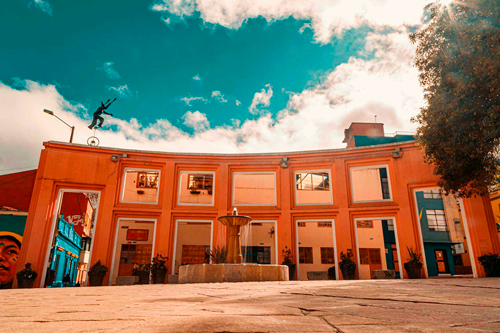
Tres Tosterona
Get ready for a dose of Tres Tosterona!
From September 12, Daniel Calderón, Luis Eduardo Arango, and Julián Beltrán will take the stage to explore masculinity's complexities through humor, drama, and daily situations that will make you laugh out loud.
How to get there?
Del amor y otras pandemias
After captivating the hearts of the audience in its first season, "Del Amor y Otras Pandemias" is returning stronger than ever in September, the month of love.
This musical journey through love, the pandemic, and the best classics of Spanish-language music is returning for you to sing your heart out and be swept away.
How to get there?
Maximiliano o de la enajenación
In a world where embracing your true self requires courage, "Maximiliano o de la enajenación" invites you on a journey into the unknown.
Through dance, drama, and contemporary theater, we will embark on a trip that might just be a voyage of self-discovery. Come and meet again with the lunatic inside you.
How to get there?
Forever Young, the Musical
LAST WEEKS
Discover your life's soundtrack by experiencing "Forever Young, the Musical." Relive the songs that take you back in time, reminding you of your best moments.
How to get there?
Spa, nature and culture in Bogotá
Includes:
- Accommodation for 5 nights.
- All ground transportation.
- 5 breakfasts + 2 lunches + 1 dinner.
- Tour guide.
- Medical assistance insurance.
- 6 days + 5 nights.
We will visit:
Troupes parade in Bogotá
Saturday, August 31, starting at 2:00 p.m., over 900 artists of all ages will take to the streets from La Santamaría Cultural Square along Carrera 7 to Calle 12 in the Manuel Murillo Toro building to celebrate one of the capital's most vibrant traditions.
The localities of Usaquén, San Cristóbal, Suba, Barrios Unidos, Los Mártires, Puente Aranda, Rafael Uribe Uribe and Sumapaz will showcase their colorful proposals as a result of community work that highlights the cultural richness, creativity, and diversity of the city.
Paul McCartney
After 12 years, the former Beatles Paul McCartney will be back in Bogotá, Colombia, with his "Got Back" tour, the most awaited tour in the world. This tour began in 2022 in the United States and will pass through Latin America at the end of 2024. Get ready to live an exciting and unforgettable concert on November 1st in Bogotá, the home of great events.
How to get there?
Gran fondo de ciclismo de Bogotá by Egan Bernal
The first urban fund in Colombia arrives in Bogotá with a route of around 115 kilometers. “El Gran fondo de Ciclismo de Bogotá x Egan Bernal” will offer participants two routes: a “gran fondo” as the main event, around 115 kilometers, and a “medio fondo” around 60 kilometers, for those who want a less demanding experience but also enjoy this route through the city streets.
Caos Bistró Méxicano
In the vibrant heart of Bogotá, Caos Bistro Mexicano radiates an alluring authenticity, transporting diners to the cobblestone streets of Mexico. In an atmosphere that fuses the Mexican bistro essence with touches of bohemian elegance, Caos offers a unique dining experience to delight all the senses. Each dish is a culinary masterpiece that blends flavors and techniques, whether delighting in a traditional Mexican dish or a creation of international cuisine. Diners can expect an explosion of flavors in every bite.
Gato Gris
Entering the traditional Gato Gris Restaurant is to be immersed in an oasis of gastronomic magic, where the warmth of the family atmosphere fuses with an enchanting bohemian style. Its culinary proposal is as diverse as it is fascinating. Here, Mediterranean cuisine blends harmoniously with international influences, creating a symphony of flavors to delight the senses. The most notable feature of this restaurant is its commitment to honoring Colombian gastronomy, adding local ingredients and traditional techniques to its menu.